|
|
GeoAstro Applets |
Astronomy |
Chaos Game |
Java |
Miscel- laneous |
Java applet calculating local conditions for crescent moon sighting
The Islamic calendar (Hijri calendar) is
a purely lunar calendar. consisting of twelve
alternating months of 30 and 29 days, with the
final 29 day month extended to 30 days during leap
years. Islamic months begin at sunset on the day
of visual sighting of the lunar crescent (hilal).
See example 2006.
New Moon is defined as the Moon's phase
when it is at the same celestial longitude as the
Sun (conjunction) and thus totally unilluminated
as seen from the Earth.
|
|
Select a location from the menu list, |
|
|
Look up your coordinates: in the Enter latitude in decimal degrees and press return key, enter longitude in decimal degrees and press return key. |
|
|
Find the time zone (and coordinates) of
cities worldwide: Interactive |
|
|
You may use the keys "m", "d", "h", "n" to increase the month, date, hour, or
minute, |
|
|
Data: Solar and lunar data are computed. New Moon: Date and time of new Moon for the year selected. daz, dalt, arcl, arcv: Computing quantities to predict lunar crescent visibility. Crescent map: not yet implemented online... |
Example:
New
Moon
on
2006
May
27
at
5:24 UT
Berlin 2006, 52.51N, 13.41E, UT+2h, May 28
sunset moonset app. altitude of the Moon's lower limb
at sunset (DALT) app. altitude of the Sun at 22:00
app. altitude of the center of the Moon
at 22:00 geocentric elongation at 22:00 age of the Moon at 22:00 illuminated fraction of the Moon at
22:00: 21:15 23:33 14.6° -6.1° 9.2° 20.7° 1d 14h 36m
3.1%

|
The time the Moon first becomes visible after the New Moon depends on many factors. The various effects are the geometry of the Sun, Moon, and horizon; the width and surface brightness of the crescent; the absorption of the Moon's light and the scattering of the Sun's light in the Earth's atmosphere; and the physiology of human vision. |
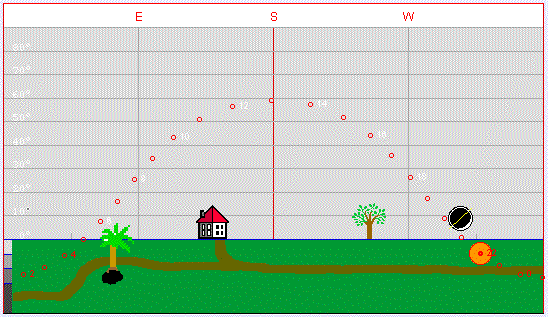

|
|
|
|
|
|
|
|
|
|
|
|
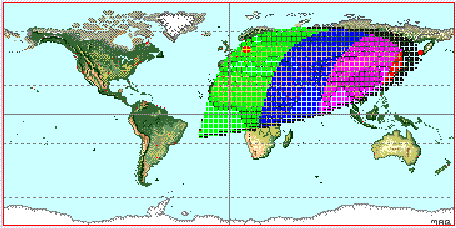
2006, Apr 27
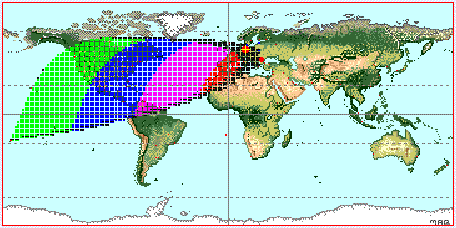
2006, May 27
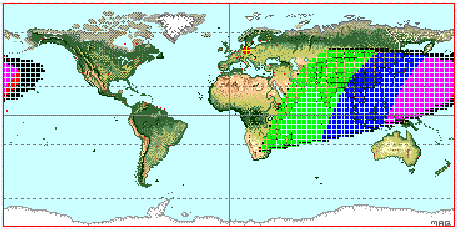
2006, Jun 25
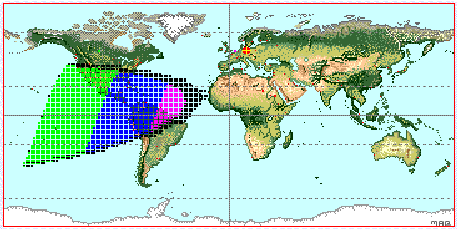
2006, Jul 25
Basic variables:
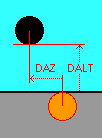 |
|
the times when the upper edge of the disk of the Sun is on the horizon, the true altitude of the center of the Sun is -0.83°. |
|
|
apparent altitude of the lower limb of the moon (with topocentric parallax and refraction corrections), at moment of sunset (or sunrise) |
|
|
|
moon azimuth minus sun azimuth, at moment of sunset (or sunrise) |
|
 |
|
arc of light, the angle subtended at the center of the earth by the center of the moon and the center of the sun |
|
|
|
is the geocentric difference in altitude between the centre of the Sun and the centre of the Moon for a given latitude and longitude ignoring the effects of refraction |
|
|
|
illuminated fraction of the lunar disk, depenging on the selenocentric phase angle |
|
|
|
Time in minutes from sunset to moonset |
The angles ARCL ARCV and DAZ are related by the equation:
cos(ARCL) = cos(ARCV) * cos(DAZ )


The chart is using the formulas (given by Yallop):
Maunder: ARCV = f(DAZ) = 11 - DAZ/20 - DAZ2/100
Indian: ARCV = f(DAZ) = 10.3746 - 0.0137*DAZ - 0.0097*DAZ2
If ARCV>f(DAZ) then the crescent Moon is visible, if ARCV < f(DAZ) it is not visible.
On my Apple PowerPC G5 (1.8 GHz) it takes about 90 seconds to create a visibility map
Last Modified: 2023, Oct 06
© 2006-2023 J. Giesen
![]()
